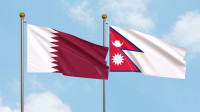National
Nepal seeks bids from Indian firms for 200 MW wet season surplus energy
Nepal Electricity Authority has permission from India to sell up to 364 MW in the Indian market.
Prithvi Man Shrestha
The Nepal Electricity Authority on Friday invited bids from Indian companies to sell its 200MW surplus energy in the upcoming rainy season under a long-term power purchase agreement.
Even though the country is currently facing power shortages amid reduced domestic production and imports, the state-owned power utility has solicited bids for trading electricity during the wet season when Nepal will have surplus energy as all run-of-the-river power plants will be operating in their full capacities.
The Nepal Electricity Authority (NEA) said in a statement that it will sell surplus energy from July 1 to November 29.
All open access consumers, regulated utilities, power distribution companies and traders having valid trading licences issued by the Central Electricity Regulatory Commission of India can participate in the bidding process, according to the notice.
“It is for the first time that we are selling as much as 200MW in the Indian market through competitive bidding,” said Suresh Bhattarai, spokesperson for the NEA. “We have, however, already sold over 200MW to Bihar [state of India] under a fixed-rate regime.”
The NEA and Bihar’s electricity authority have an agreement in place to buy and sell electricity at INR 6.18 per unit as per their respective needs, according to the NEA.
Nepal has received approval from India for selling 364MW of electricity at any time in the Indian market at competitive rates. In November last year, the NEA was allowed to sell 39MW of electricity from two hydropower projects—Trishuli (24MW) and Devighat (15MW).
In early April this year, the Central Electricity Authority of India allowed the NEA to sell an additional 325MW generated from Kali Gandaki Hydropower Project (144MW), Middle Marsyangdi Hydropower Project (70MW), Marsyangdi Hydropower Project—all developed by the NEA, and Likhu 4 Hydropower Project (52.4MW) developed by the private sector.
“We invited a tender to sell 200MW out of the approved 364MW. The company making the highest bid will be selected,” the statement quoted Kul Man Ghising, managing director of the NEA, as saying: The rest (164MW) will be sold through India Energy Exchange on a daily basis, Ghising said.
NEA officials said they are not sure about the price the Indian bidders are willing to pay for its electricity. “Based on the bids, we will be able to figure out possible prices for a long-term power purchase agreement,” said Bhattarai.
Given the ongoing power crisis in India, the NEA believes there is an opportunity for it to sell the electricity for a better price than last year. While the demand for electricity is high in India, supply has been constrained by the closure of coal-fired plants amid rising coal prices and its short supply globally.
In early April, the Indian government capped the maximum price that bidders can quote at the power exchange market at INR 12 per unit. Earlier, electricity at the power exchange market was sold at as high as INR 20 per unit.
“There is a projection that power supply in the Indian market will continue to remain the same for some time. So there is an opportunity for us to sell our electricity at a higher rate in the upcoming monsoon,” Ghising told journalists at a recent press meet.
Despite the opportunity to sell the electricity for as high as INR 12 per unit in the power exchange market, the NEA has chosen to sell its electricity under a long-term contract and therefore the selling price is expected to be lower than that of the day-ahead market in the Indian Energy Exchange (IEX).
The Day-Ahead Energy Market (day-ahead market) is a financial market where market participants purchase and sell electric energy at financially binding day-ahead prices for the following day.
“The main aim is to discover the price for long-term power purchase agreement for Nepal’s electricity and also to diversify the risk because prices in the IEX are volatile,” said Bhattarai. “Under long-term bilateral contracts, we can secure certain prices for a fixed period.”
Last year, the NEA sold 39MW of electricity from the beginning of November to early December. “Average price over the period for our electricity was INR 3.5 per unit,” said Ghising.
The NEA expects the country’s installed capacity to reach around 2300MW in the upcoming monsoon. Peak time demand is expected to reach 1900MW. But power demand will vary depending on time as the demand rises in the evening and falls substantially at midnight, according to the NEA.
Spokesperson Bhattarai said the NEA expects surplus energy of 600MW-800MW in the upcoming monsoon and it has made a request to the Indian authority seeking approval for selling electricity from more projects including the 456MW Upper Tamakoshi.
The NEA has asked interested companies to submit their bids by May 27. But no company can submit a bid for less than 50MW, according to the NEA.
The power utility body said it would sell the surplus energy through the Dhalkebar-Muzaffarpur Cross Border Transmission line.




 16.12°C Kathmandu
16.12°C Kathmandu













%20(1).jpg&w=300&height=200)

